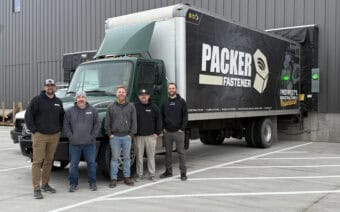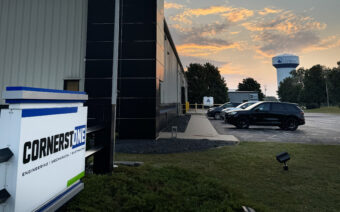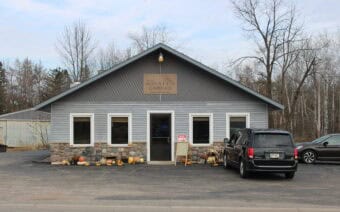
November 13, 2023
OSHKOSH – From the assembly line in Neenah to the Pentagon on 9/11 to a Canadian scrapyard for parts, Oshkosh’s T-3000 foam-carrying rescue truck or “Foam 331” has had quite the journey.
Foam 331 was among the first to respond to the Pentagon after a hijacked Boeing 757 slammed into the building Sept. 11, 2001.
The Oshkosh Airport Products’ fire engine recently found a permanent home – the Smithsonian National Air and Space Museum’s Steven F. Udvar-Hazy Center located in Chantilly, Virginia.
“We are extremely proud to be a part of this,” Jack Bermingham, business unit director for Oshkosh Airport Products, a subsidiary of Oshkosh Corp.’s Pierce Manufacturing division, said.
We take tremendous pride in the vehicles we build daily and put our heart and soul into it. At the end of the day, it’s not about Oshkosh – “it’s about the people who responded that day and everyone else who was affected.”
Bermingham said Oshkosh Airport Products builds and designs airport, rescue and firefighting vehicles (ARFF).
“The Smithsonian vehicle was an older Oshkosh ARFF vehicle,” he said. “It was built in 1999. When the tragic events of that day struck, the truck was stationed at Ronald Reagan Washington National Airport when it was called to the Pentagon.”
Bermingham said the airport firetrucks are designed to bring all water and agent (foam) to the end of a runway or another location where jet fuel is involved as quickly as possible.

Jack Bermingham
“These vehicles are almost like hot rod firetrucks,” he said. “They’re fast and carry everything needed – there are no fire hydrants on a runway. They’re also designed to go off-road and navigate some different terrain around airports. Planes don’t always crash on runways. That makes it unique compared to a traditional firetruck.”
The Smithsonian’s curator of aeronautics, Roger Connor, said on 9/11, Foam 331 had more than 3,000 gallons of water on board, along with 420 gallons of foam and 500 pounds of a dry chemical suppressant specifically formulated for use on jet fuels.
A unique journey
In 2001, Foam 331, a T-3000 model truck, was only two years old – just at the beginning of its life cycle, Bermingham said.
“After responding to the Pentagon, that truck went back into service and lived the rest of its useful life at the Ronald Reagan Washington National Airport,” he said. “These vehicles typically last 12-15 years, so if you do the math, it had a long life.”
Foam 331 was transferred to service at Dulles Airport before its retirement in 2016.
“In about 2016, it was sold by the airport to a Canadian company,” he said.
Bermingham said it’s not uncommon for these vehicles – no matter their historical importance – to be sold off into the second-hand market.
“After their useful life is over, they can be sold off and used in a variety of ways,” he said.
Eventually, Bermingham said Oshkosh Airport Products was able to get its hands on the vehicle.
“All I know is, in 2018 or 2019, we got our hands on it. We wanted to do something with it, but we weren’t quite sure what at that point.”
Even if that meant keeping it onsite in Neenah, Bermingham said.
“Let’s get our hands on it and go from there,” he said. “We knew it was important to do our part to get the vehicle back – it’s historic. It’s not only about showing how this AARF vehicle was used at the Pentagon, but it’s to show honor and remember those who lost their lives.”
As the years passed, Bermingham said a gentleman named Bill Stewart – who had been an airport firefighter in the region reached out.
“(He) learned we had the vehicle and was trying to get some momentum (going) to restore it and find the right place for its final home.”
From there, Bermingham said Stewart got Oshkosh Airport Products in touch with someone from the Smithsonian.
“There was immense interest from the Air and Space Museum to be able to tell the truck’s story and bring attention to its significance during 9/11,” he said.

Before being delivered to the Smithsonian National Air and Space Museum, Foam 331 had to be cleaned up, repainted and brought back to its original 2001 state. Submitted Photo
Bermingham said the next stage in the process was working with the Smithsonian to restore it to its 2001 days.
“We worked with the curator at the Smithsonian,” he said. “The Smithsonian wanted it restored to how it looked as it was in 2001. For the vehicle’s life and duty after 2001, it had different upgrades and graphics, which is typical. We worked hand in hand with the Smithsonian to bring it back (to its original state). We repainted it, cleaned it up, found different parts, etc. It was incredible to see the team’s passion come out. We wanted to get everything right.”
Bermingham, who has yet to personally see the vehicle on display at the Smithsonian, said the restoration process took about six months.
“We then were able to deliver it to the Smithsonian,” he said. “We’re proud to be a part of the process. I look forward to seeing it in person someday.”
Connor told the U.S. Department of Defense News the museum “is honored to be able to present the vehicle.”
“The ability to tell a more comprehensive 9/11 story is essential for acknowledging and commemorating one of the most traumatic moments in our nation’s history,” he said.
The Steven F. Udvar-Hazy Center – a Smithsonian National Air and Space Museum secondary location – is located at 14390 Air and Space Museum Parkway in Chantilly, Virginia and displays thousands of aviation and space artifacts, including the Space Shuttle Discovery, a Blackbird SR-71, a Concorde and now Foam 331.
For more information on the Smithsonian National Air and Space Museum, visit airandspace.si.edu.
 Trust Point: Meeting fiscal, volunteer needs across communities
Trust Point: Meeting fiscal, volunteer needs across communities Wanta & Son: 50 years, three generations, countless buildings
Wanta & Son: 50 years, three generations, countless buildings








